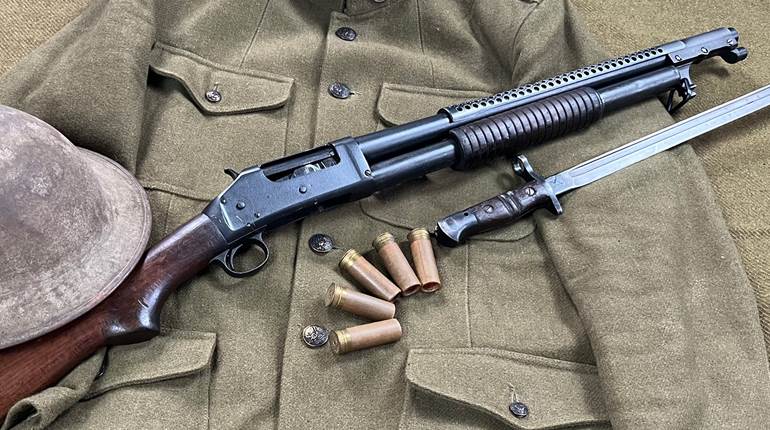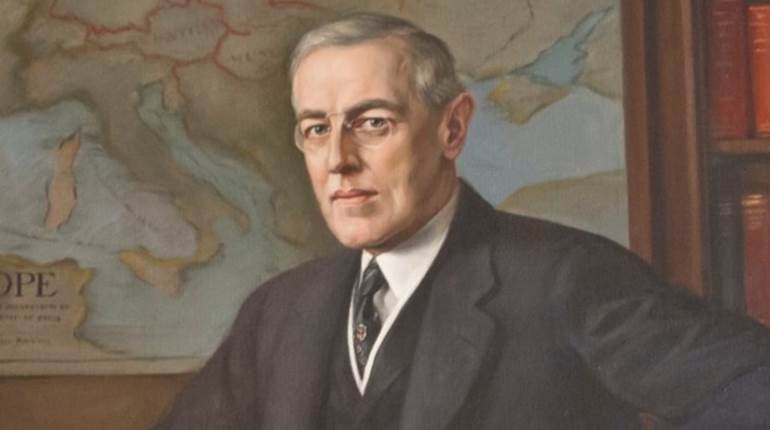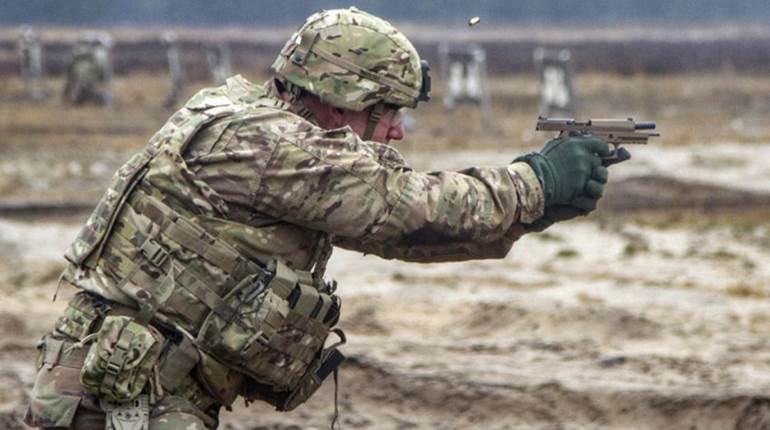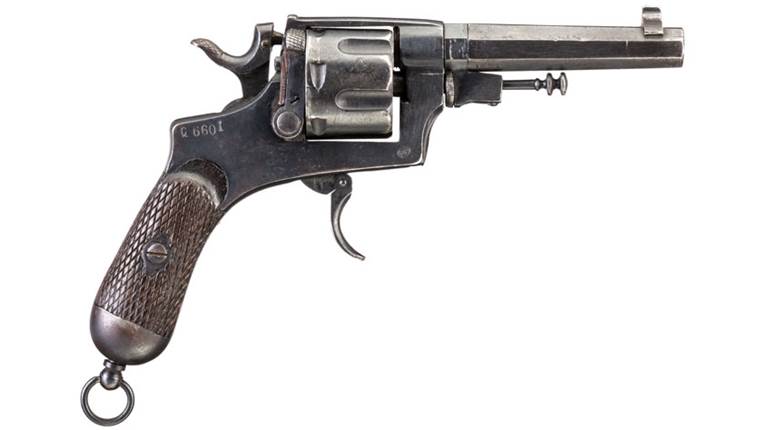
Top image: M1911 pistol inspection with the 1st Battalion of the Signal Corps in France during May 1918.
The “U.S. Pistol, Caliber .45, Model of 1911” had already been blooded in combat before it reached the grand stage of the Great War. Action in Mexico and Haiti had shown the modern semi-automatic handgun to be effective. By 1918, in the hands of the Doughboys of the American Expeditionary Force (AEF), the Kaiser’s men would experience the hammering power of the big .45 ACP automatic pistol and its 230-gr. slugs. 
Here’s what the AEF expected in a service pistol as spelled out in the 1918 Manual of the Automatic Pistol, Caliber .45, Model of 1911:
“In any military pistol there are certain essential qualities:
"Accuracy.
"Power to stop the enemy at once.
"Rapidity of fire.
"Reliability.
“The automatic pistol, caliber .45, Model 1911, satisfies all of the above conditions, and as a military pistol is superior to any other made. As a target pistol, it lacks many qualities. The refinements for target work, however, would prove a detriment in hard field service.”
Pistol mechanics: M1911 pistol instruction at Camp Upton during 1917.
America’s entry into World War I found the U.S. military sorely lacking in small arms. The M1911 pistol was particularly scarce, with only about 75,000 to be found in service. Colt and Remington-UMC went into full scale production and managed to produce a little more than 643,000 M1911 pistols by the end of World War I. The bad news was that number represented only about a quarter of the pistols that the U.S. Government required.
Clowning in France, summer 1918. Twin .45 pistols and experimental body armor.
The M1911 was issued to both officers and NCOs, and proved popular with anyone who could acquire one. Looking through the Signal Corps collection of World War I photos, many AEF troops can be seen carrying a pistol, so it appears that most of the M1911 production made into the hands of our combat troops.
It certainly made quite an impression on the Doughboys and the Germans alike. Tales of the man-stopping power of the M1911’s .45 ACP rounds quickly grew into legends, like the description of a .45 exit wound the size of a “Derby hat.” Ballistic myths aside, the M1911 made its mark in combat in the trenches and the advance to break the Hindenburg Line in the war’s bloody finale.
Into the deadly woods: Doughboy with a M1911 pistol in the Argonne Forest, October 2, 1918
Sergeant Alvin York, possibly the single most famous American soldier of the 20th Century, is noted for his uncanny accuracy with a rifle. But it was his use of the M1911 pistol that saved his life and broke the will of the German troops that surrounded him. During the Oct. 8, 1918 attack by the US 328th Infantry Regiment against the German-held Hill 223 (near Chatel-Chéhéry, France, in the Meuse-Argonne sector) York earned the Medal of Honor. When German troops attempted to stop York’s deadly sniping with a bayonet charge, the good sergeant dropped six attackers with his M1911 pistol, shooting them in order from the last man in line to the first. After this, the German commander surrendered, and York took 132 German troops as prisoners, along with more than 30 machine guns.
Actions like York’s proved that the pistol was still a valuable tool in modern warfare. The timing of its use was a critical factor. Apparently, American troops needed to be reminded that their fascination with the big pistol needed to be tempered with a healthy dose of realism and hand-gunner’s skill. To that point, the following is an excerpt from the U.S. Army’s Manual of the Automatic Pistol, Caliber .45, Model of 1911,” published in Nancy, France during February of 1918.
Frank Schoonover’s painting of Sgt. Alvin York during his Medal of Honor-winning heroics on October 8, 1918.
The Pistol As An Emergency Weapon
“Too much stress cannot be laid on the fact the pistol is an emergency weapon. The man who wants a stock on his pistol so that he can shoot it at a distance of several hundred yards has no understanding of the function of the arm. It is solely for the personal protection of the bearer when the enemy is within very short range and there is no possibility of accomplishing more with the other weapons with which the soldier may happen to be armed.
“The member of an automatic rifle or machine gun squad who stops serving his rifle or machine gun to indulge in pistol practice at the enemy is wholly without a proper sense of his duty to his comrades. At the same time the stupid man who does not use his pistol when the enemy is on top of him and his gun is jammed or it is no longer possible to use it profitably, deserves no better fate than that which he will probably get, that is, immediate death.
“When conditions are such that the opportunity for the proper use of the pistol in the near future appears probable, every man armed with the pistol should so place his weapon that it can be used in the minimum of time. What this position will be will depend on the circumstances. It may be on the parapet alongside the gunner, or on the flap of the carrier’s musette, or in the holster.
“For the average man, 25 yards may be taken as the maximum range at which the pistol should be fired. To fire at longer ranges will usually result in no casualties for the enemy but only an empty pistol at the crucial moment. This does not apply to a very small percentage of expert shots, but a man should be quite sure that he can be classed as such before violating the general rule.”
A century later, this remains sound advice. In 2018, many thousands of these proud old warrior handguns are passing from military stocks to the hands of the Civilian Marksmanship Program, and ultimately into the hands of collectors and civilian shooters. Some wonder aloud why the M1911 ever needed to be replaced in the U.S. military at all. Time and the tide of technology washes away much of what we hold dear, regardless of the reasons the government presents.
A member of the 30th Infantry Division’s 6th Balloon Company keeps watch on German Lieutenant Marwede, shot down while attempting to burst one of their observation balloons.
I can tell you that the M1911 served three generations of my family in foreign wars; my grandfather in World War I, my father in World War II, and my eldest brother in Vietnam. Thankfully, all came home. An M1911 sits within arm’s reach as I write this. Who am I to abandon a family tradition, and a century worth of effective life insurance?
Marines training with French instructors during the spring of 1918. What could a Frenchman teach a Marine about shooting?























![Winchester Comm[94]](/media/1mleusmd/winchester-comm-94.jpg?anchor=center&mode=crop&width=770&height=430&rnd=134090756537800000&quality=60)
![Winchester Comm[94]](/media/1mleusmd/winchester-comm-94.jpg?anchor=center&mode=crop&width=150&height=150&rnd=134090756537800000&quality=60)












